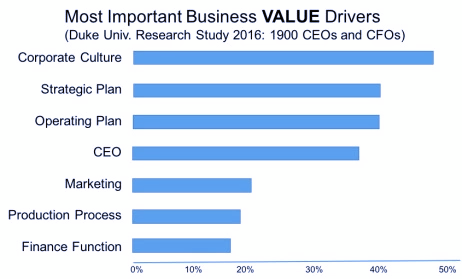ATD Blog
The 7 Corporate Culture Questions Every CEO Should Ask
Thu Jun 29 2017

Leadership and learning are indispensable from one another.
—John F. Kennedy
I like questions. Questions make people think. Statements may go in one ear and out the other, but a good question will bounce around inside your head until you come up with an answer. And good questions often breed even better questions. And the outcome of all these questions is often a new insight.
Executives have been trained to make statements, to deliver facts and information and overwhelm others with massive spreadsheets no one can understand. It’s what I call “razzle-dazzle” management. It’s energetic and impressive, but not really educational or insightful.
Education comes from the Latin verb educo, which roughly translated means “to lead out or to draw out.” Real education, then, comes from the ability of teachers and leaders to draw out insights and answers rather than pour in facts and data. And one of the best ways to draw out new insights from others is to ask questions!
While much time is spent in senior team meetings talking about sales, products, costs, and profits, little time is spent on corporate culture, even though culture directly affects performance. Duke University Fuqua School of Business surveyed nearly 1,900 CEOs and CFOs. The result was that corporate culture was rated as the number one driver of economic business value.

Here are seven important culture questions you should ask:
#1. What is the business case for culture in our company?
Before you can really use the power of culture as a business value driver, it is important to try to understand the cost of a poor culture and the business benefit of a culture that is aligned with your business strategies. One of the ways to get your team to understand the business case for culture is to talk about how cultural barriers such as poor cross-functional handoffs, withholding information, not following up with teammates in a timely manner, and other dysfunctional behaviors get in the way of project delivery and execution on important strategic initiatives.
Another broad rule of thumb is to ask your team how much of a productive day’s work is wasted through blaming, finger-pointing, slow responses, lack of trust of other departments, poor teamwork, poor customer service, and so on. Usually the number is around 30 percent. Take your total employee cost figure and multiply it by that number (say 30 percent), and you get the cost of a poor culture. It’s a staggering figure in most cases.
#2. Is our culture an asset or a liability? How would we know?
Does your team know the current strengths and weaknesses of your current culture? Have they done a culture assessment? Have they held conversations with their team about the culture? A strong culture can be a significant competitive advantage; anyone will sooner or later copy your products and services, but they can’t copy your unique culture.
#3. Is building and sustaining a high-performance culture a part of our formal, written business strategy?
When an initiative shows up on the formal strategy document and specific accountabilities get assigned, more often than not those initiatives get funded and resourced. Have you put a high-performance culture as one of your key business strategic initiatives? Do you have specific plans with milestones and deliverables against it? Is it properly funded or just a “hope to improve” item? What gets measured and reported often gets done!
#4. Is alignment with culture and values a part of performance reviews, bonuses, and promotions?
In many companies, values and behaviors are just words on the wall or in the employee handbook and have little impact on the day-to-day work. By putting culture and values as a significant part of performance reviews, promotional criteria, and bonuses, they suddenly become more important. And if the scores are given through a 360-degree evaluation process, they have even more power to influence behavior.
#5. Have we mapped the various subcultures and their alignment with the overall values and strategy of our business?
One of the major recent insights into corporate culture is that most companies are composed of numerous subcultures rather than one overall corporate culture. And these subcultures can be strong influencers of “how things get done around here.” If you don’t understand the subcultures inside your company, then you really don’t understand your operational culture. In some cases, subcultures are strongly aligned with the vision, values, and business strategies. And in other cases they present significant barriers to productivity and positive change.
#6. Do we as a senior team talk about culture as often as we talk about costs, profit, and business performance?
Much of corporate culture is developed through stories and the things people talk about the most. Stories of highly creative or accountable individuals are often told to new employees long after the individuals have retired or left. Stories contain the viral seeds of your culture. If the senior team routinely talks about sales, costs, and profits, but not about values and cultural behaviors, the few times culture is mentioned it will be discounted, because everyone knows how important cost is to management, not culture.
#7. Does our new employee hiring and onboarding process help people understand our desired culture and why it is important?
When was the last time the senior team sat through a new employee indoctrination process? Too often these are becoming menu driven, and few put much emphasis on expected behaviors and culture. It is important to remember that if you don’t indoctrinate new employees, at all levels, in the company culture, they will bring their old company culture with them as the default. And when many employees come on board without a good acculturation process, you will wind up with a very fragmented culture.
These seven questions, as good as they are, often lead to even better questions being asked and explored by your leadership team, and will undoubtedly spark a new focus in everyone’s part on the importance of culture to your business success.
And a bonus question: How often do we have open debates and reviews of our culture and values?
Sometimes asking the right questions takes more courage than finding the answers!
